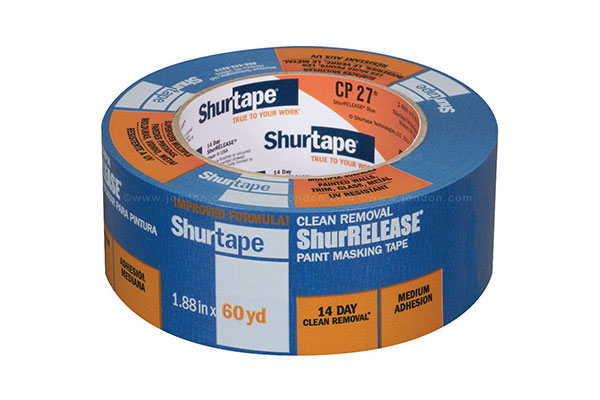When creating containment chambers for mold remediation or category three water damage, painter’s tape or preservation tape is often used to install and seal 6-mil poly sheeting to walls, doorframes, HVAC vents, or other containment construction pieces. These tapes are made to hold aggressively and the be pealed off afterwards without causing damage to painted walls and baseboards or stained woodwork.
The usage of these tapes is not limited to just containment chambers though. They can be used to cover electrical outlets to keep out water and humidity. They can be used to protect almost anything.
Painter’s Tape
Painter’s tape generally comes in three varieties and in various widths. The first type is just a standard taping and masking product. It is most often blue in color, but all these tapes are available in colors other than blue also.
The second type is basically the same except it has a lighter adhesion. This type is good to use on more delicate surfaces that may be damaged by stronger adhesion. More delicate surfaces would include stained furniture and finished hardwood floors.
Stronger adhesive tapes, especially when left on a surface for longer than just a couple of days, may cause finish to come off when the tape is removed. It’s been found that the heat from drying equipment may affect the adhesive properties of the tape.
The third version of painter’s tape has more adhesive than normal and is extra sticky. This type holds better on textured surfaces like stucco and brick. Sometimes using this stickier variety around the access doors in containment chambers is recommended because of its high adhesive qualities.
Preservation Tape
Preservation tape, also known as “Hull Tape” is made to be applied directly to surfaces where you would not want to leave any adhesive residue. It can withstand exposure to heat better than a painter’s tape and often has added protection against UV rays. It has good tensile strength and has excellent adhesion when pressure is applied. It is also usually thicker than painter’s tape, around 10 mil thick. It too comes in various widths and colors.
Applying These Tapes
If you are applying the tape to baseboards or wall trim, it is best to damp wipe the surfaces before taping. Even the stickiest tape won’t hold to a dusty surface. If you want to speed up your taping, you can find tape applicators that resemble scotch tape dispensers. Once the tape is in place, gently press the edges down with a putty knife or other similar tool. When you come to a corner, run the tape an inch or so up the wall, then use a utility knife to cut a straight edge along the perpendicular wall or baseboard.
Containment Taping Tips
For the last several years I have erected containment chambers by building temporary walls with 2x4s and poly sheeting. I use pressure to hold the walls in place so that I don’t have to screw them into drywall or wood trim. I use painter’s tape to seal the poly along the sides, top and bottom against the 2x4s. I then tape the sheeting down each stud that I used to build the wall and staple the tape along all edges and down the wall studs. Then I add a second piece of painter’s tape over top of the staples. It takes a little more time but I have never had a chamber come apart or fall down before it is torn down at the completion of my work. Homeowners seem to appreciate the secure containment I provide.
Experience Counts
Water Mold Fire Restoration’s certified water damage and mold remediation technicians have the training and equipment necessary to successfully cleanup these any complex water-related damages. They are standing by 24/7 to answer your call for help. Whether your loss is caused by water, mold, or fire, we can provide the cleanup solutions you need. Call us at 800-905-0277 or email us at help@watermoldfire.net and talk to a live person, not an answering machine.








